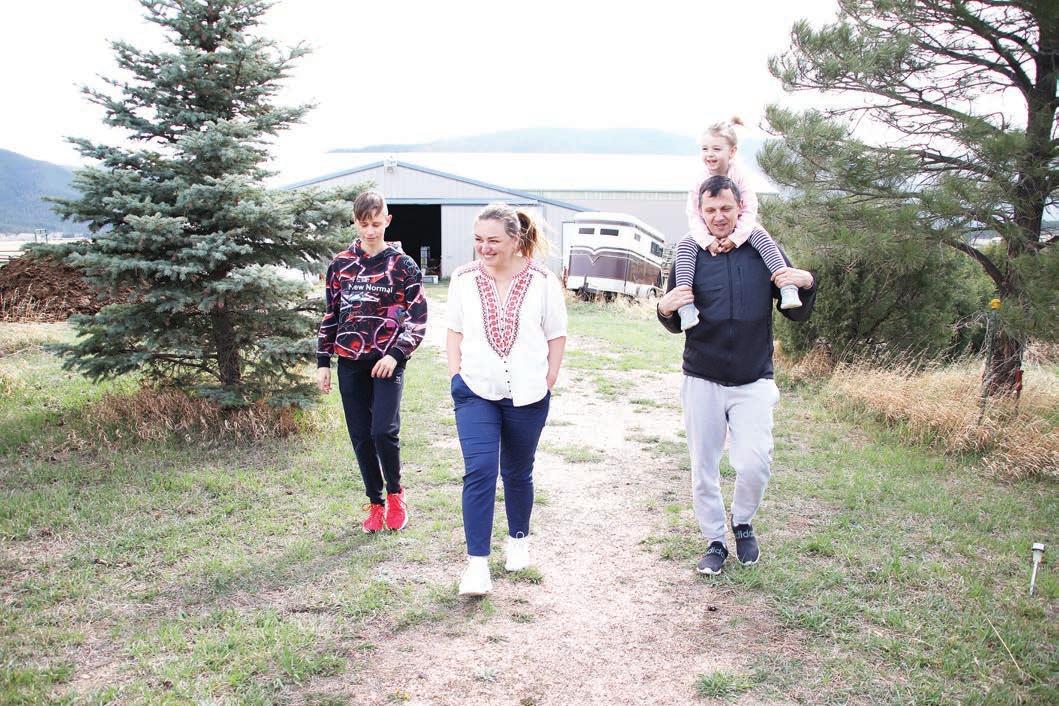
28 minute read
SEE UKRAINE
region. Family members are caring for the Sheveria’s pets and keeping them informed on the status of the war. Recently, they learned the bombing has moved even closer to their home.
Maryna and Oleksandr spoke about their family’s journey to Colorado from the living room of the the Larkspur home.
While it’s her husband and children’s first time in the United States, for Maryna, it’s not such an unfamiliar place. Just down the road is Douglas County High School, where Maryna spent a school year during an exchange program 23 years ago. The Larkspur home and its inhabitants are familiar too, as it’s the same host family Maryna lived with during her exchange program.
As they spoke, Maryna translated for her husband Oleksandr, 39, who is working on learning English.



Just a few months ago, their family had started 2022 like many others. They had fitness goals, resolutions to learn new languages and plans for the future. On the weekends, Oleksandr would grill food for the family, or they would take their kids to play at a local park.
Oleksandr owned a business selling used trucks and cars. Maryna worked for an IT company.
Then, on Feb. 24, everything changed.
The day before the invasion, Maryna dropped Oleksandr off at the border of Ukraine, where he planned to travel to Budapest to catch a flight for a work trip. After she heard the news a few hours later that Russia was attacking, Maryna called to tell him she was planning to flee.
She gathered the kids into her car and tried to begin the journey. But she could not find any gas.
For nearly an hour, she searched for a gas station where she could fill up. While there wasn’t a shortage at that time, stations were limiting how much customers could purchase. And the lines were tremendously long.
Eventually, she filled their tank as much as possible and began driving to Budapest to meet with Oleksandr.
When they finally reconnected, the family traveled to Germany. Once there, Maryna received a social media message from Helen Kellogg, who had hosted her as an exchange student back in 1999.




Maryna and Oleksandr Sheveria walk with two of their kids outside of the home where they are staying in Larskpur. From left, the younger Oleksandr, 14, Maryna, Oleksandr and on his shoulders, 4-year-old Taisia. PHOTOS BY ELLIOTT WENZLER



Maryna and Oleksandr Sheveria smile at each other on their new porch in Larkspur.
Four-year-old Taisia Sheveria sings while climbing a fence in Larkspur. Behind her, a Ukrainian fl ag waves.

Kellogg offered to again host Maryna and her family at her home.
Exchange program
Kellogg, who is Ukrainian but grew up in the United States, began hosting Ukrainian students because she wanted to continue speaking the language, which was the first she learned.
Mayna spent about nine months attending Douglas County High School in Castle Rock and came back again a few years later. Kellogg remembers trying to convince Maryna to immigrate to the U.S.
After Maryna and her family decided to accept Kellogg’s offer, they spent several weeks in Germany, waiting for their tourist visa to be approved. During that time they stayed in various hostels, hotels and apartments in Germany, often experiencing generosity from strangers.
Some allowed them to stay for free in their hotel, others gave them food and one man who saw their Ukrainian license plate at a gas station insisted upon giving them cash.
Meanwhile, Kellogg, who has worked for the county government for about 37 years, asked the commissioners if they would consider supporting the family’s visa application. They agreed to do so and wrote a letter of support.
Colorado Senator John Hickenlooper and Representative Ken Buck also voiced support for their application.
Kellogg and her husband agreed to sponsor their visa, which means they will provide shelter, clothing and food for the family.
Following an interview and a wait period, their application was approved and they flew to the U. S. in mid-March.
Life in Larkspur
These days, the family spends their time mostly with each other in the house and yard in Larkspur. They don’t have access to a vehicle, so their travel around the area has been limited. They went out hiking once and also visited the Denver Botanic Gardens.
Mostly, they stay in. Maryna braids the three girls’ hair or the kids play with Pokemon toys. Oleksandr works on learning English.
Since arriving, Kellogg and Maryna have tried to restrict how much news they take in from the war.
“It kinda reminds me of like 911 where you just sit there and you’re so horrified going, ‘how in the heck can this be happening?’” Kellogg said.
They especially try to avoid letting the kids see or hear too much of it. While the kids know there’s a war going on, Maryna and Oleksandr try not to talk about it in front of them.
For Mayna and Oleksandr, there are some complicated emotions that cross their minds as they wait to see how the war will play out.
“At first, I kind of felt guilty that I left the country. But I usually stop myself from that thought when I start feeling like that because I look at my children and I understand that it was the right decision,” Maryna said.
Both Maryna and Oleksandr’s parents are still in Ukraine along with their siblings, friends and other relatives. With some, they are still in touch and hear consistent updates about the state of the war. Others, they can’t contact and don’t know where they are or how they are doing.
For now, the couple can’t work because of their status as tourists. They have applied for Temporary Protection Status from the U.S. and hope if it’s approved, they will be able to begin working in the community.
“I miss the regular life, when you go to work, when you talk to people, just a regular schedule,” she said.
If that status is approved, perhaps they can buy a car and find a place to rent.
All they can do until then, however, is wait.
The kids, ages 4, 8, 11 and 14 and are currently learning remotely in a Ukrainian school but if the family is granted TPS status, they hope to attend local classes.
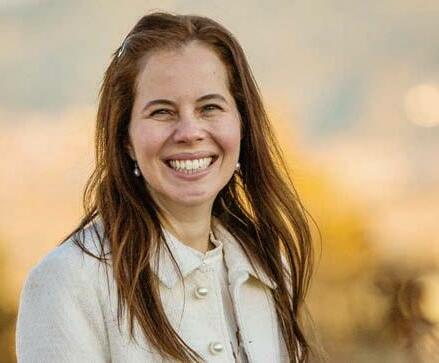
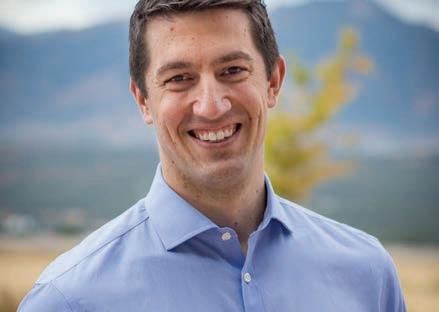





Focus is on helping struggling students
BY ELLIOTT WENZLER EWENZLER@COLORADOCOMMUNITYMEDIA.COM
More students experiencing a mental health crisis in Douglas County schools will soon have access to trained responders after county commissioners funded an expansion of the Youth Community Response Team on May 3.
The Youth Community Response Team, which pairs mental health clinicians with law enforcement to help people crises, currently serves 42 schools in the county. With the additional funding to creat a second YCRT team, the program will be able to serve all 92 schools in the district, including private and charter schools.
“We have seen — since the initiation of the pilot of the community response team — a really great added layer of support for our students,” said Stephanie CrawfordGoetz, the mental health director for Douglas County School District. “We’re getting really good at having all eyes on kids, making connections and knowing when they’re presenting signs that they’re at risk.”
The YCRT is an expansion on the country’s original Community Response Team, which began in 2017 and also pairs law enforcement with clinicians to stabilize mental health crises in the county.
“Having two specialized teams means that the YCRT team will no longer have to prioritize which call they want to respond to,” said Maggie Cooper, special projects manager for the county.
The commissioners unanimously approved a motion to reallocate about $417,000 for the second youth team. That funding will provide a clinician and case manager for three years. The Douglas County Sheriff’s Offi ce has agreed they can provide an existing deputy for the program this year but may need to hire a new employee for the position beginning in 2023.
In 2021, the YCRT treated 71 children on site and placed 26 into treatment facilities. In that whole year, the team responded to 290 referrals, according to a memo about the team. In the fi rst two months of this year, the team responded to 111 referrals.
“This upward trend is likely to continue with children and youth returning to in-person learning,” according to the memo.
Following the deadly STEM School Highlands Ranch shooting in 2019, the county dedicated $13 million for school safety initiatives, including $823,000 earmarked for mental health services. So far, about $185,000 of that has been spent on surveys, social-emotional curriculum and safety trainings.
During the meeting, Commissioner Abe Laydon asked CrawfordGoetz about why the majority of county funding for mental health initiatives has not yet been utilized. She responded that the COVID-19 pandemic had delayed the rollout of some of their plans but they are still working on carrying out other portions of their initiative.
Laydon said he hopes to see programs where students struggling have some kind of intervention before it becomes a crisis.
“I would be okay with this as long as I think there’s an understanding that you are doing some measure of signifi cant peer support from other sources,” Laydon said.
Crawford-Goetz said it is their priority in these situations.
“First and foremost is prevention, early intervention, being proactive, reaching all of our students before it needs to get to a point where students are in crisis,” she said. “That is where we want to focus the majority of our efforts but we know that there will always be a segment of our population that has intensive needs and we want to be responsible for them as well.”
The initial Youth Crisis Response Team was created in November 2019, just a few months after the STEM shooting.
After students are connected with the youth team, they decide the best way to meet their immediate needs. Then, the student continues to be monitored and contacted by a case manager.


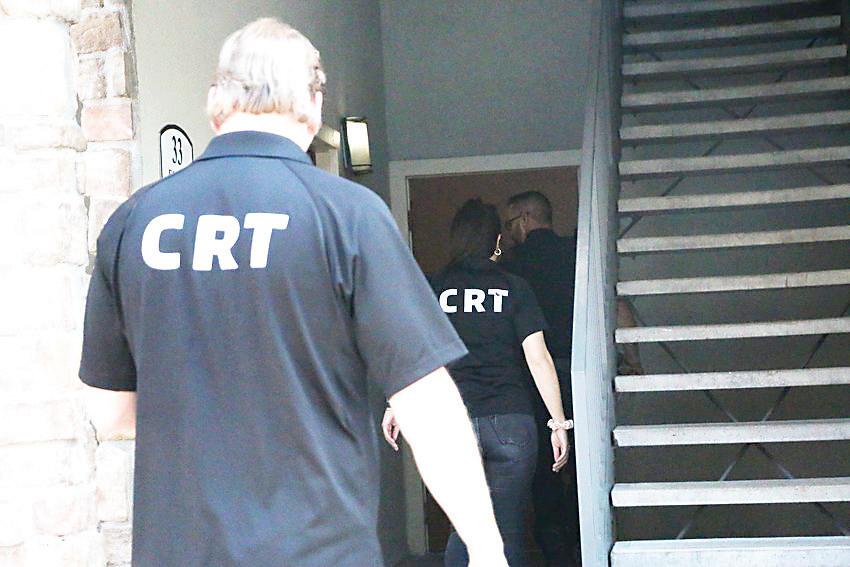
Community Response Teams are being utilized by the Douglas County Sheri ’s O ce and the Castle Rock, Parker and Lone Tree police departments along with the local
school district. PHOTO BY THELMA GRIMES
Dear Davis Schilken, My family and I are setting off on our dream vacation. We will be traveling around the world for one year on planes, trains, and automobiles! We have an extensive itinerary that covers all six continents, allows us to work remotely, and teach our children on the road. What should we know when it comes to handling our Estate Planning if we’re going on vacation and traveling? Sincerely, Traveling Tommy
Dear Traveling Tommy, Wow, that sounds like the opportunity of a lifetime. We commend anyone that has the gumption to put something like this together! There are a few things you should know when it comes to traveling and your Estate Planning. Always remember, your location of domicile will determine where your Estate is administered. A few things that prove your domicile are your Driver’s License, Tax Filing, Permanent place of residence, and place of involvement. That being said, if something were to happen to you while traveling (locally, nationally, or internationally), the laws where you reside will be the laws that control your Estate Plan and Estate Administration. (Ex. You are domiciled and plan in the State of Colorado, travel to Thailand, and pass away in Thailand. The laws of Colorado will control your Estate Administration.) The fi rst thing you will want to do is review your Estate Planning documents. This includes your Will, Trust (if you have one), Powers of Attorney (Financial and Medical), and your Living Will/Medical Directives. You will want to ensure that your plan still works for you. Next, you will want to communicate with your Fiduciaries or “helpers.” Make sure they know the location of your documents and how they work. Obviously, don’t broadcast your Estate Plan to the world. These are private documents that only the authors and fi duciaries should have knowledge of. You will also want to make sure that your Fiduciaries know where you are traveling. Give them an itinerary or a plan of the places you intend to go and the things you intend to do. You can never be too safe or plan too much when it comes to your Estate Plan and traveling.
If any of your documents need to be updated before you go – don’t hesitate to reach out! Call our offi ce for a no obligation meeting (303)670-9855.
BOARD
FROM PAGE 4
across a variety of issues,” he said.
Peterson said it’s OK to disagree with other people who attend school board meetings. It’s OK to be critical of board members, he said.
“This is not a place for partisan political attacks,” Peterson said.
His priority is allowing each board director, presenter, and public commenter to speak without interruptions, he said. Reactions to public comment is “certainly not appropriate if it interrupts speakers,” he said. Applause in-between speakers, “I actually don’t mind that,” he said.
Although past boards were more strict about prohibiting reaction to public comment, Peterson has taken a different approach, and permitted applause or cheers inbetween
He has felt attendees were compliant in instances when he asked someone to settle down. Peterson said he can’t always see or hear what happens in the audience. He was leery of labeling specifi c conduct as bullying or intimidation.
“Sometimes it’s diffi cult to monitor those situations,” he said.
Peterson said he will be relying on district staff more often to help him keep the room’s discourse civil.
Peterson said board directors also bear a responsibility to model the behavior they want to see among the community, particularly when directors disagree. The April 26 meeting featured all 7-0 votes with the exception of one 6-1 decision, which boiled down to an administrative issue, he said.
Whether or not fraught school board meetings are the new normal is “a good question,” Peterson said, and one he doesn’t have the answer to. But Peterson is optimistic, he said, that tension in DCSD will simmer down.
“And we can focus more on what unites us than what divides us,” he said.

Records from sick-out remain unreleased
BY MCKENNA HARFORD MHARFORD@COLORADOCOMMUNITYMEDIA.COM
A judge’s order resulted in the Douglas County School District naming a man who in February requested the names of teachers who were absent on the day of a contentious sick-out and then withdrew his request.
Previously, the school district had declined requests from Colorado Community Media and Kyle Clark of 9News to produce the withdrawn request and who fi led it, which prompted Clark and 9News’ parent company, TEGNA, to sue the district for the record.
On May 5, a judge ruled in 9News’ favor, ordering the school district to immediately release the withdrawn request.
“There is no authority of which this court is aware, that permits a requester to remove a CORA request from its status as a public record by simply asking that it be withdrawn,” Douglas County District Court Judge Jeffery Holmes wrote in his order. “This is especially true when, as here, a CORA request is made for an Original Request prior to any effort at withdrawal and the Original Request clearly remained a public document seeking and triggering government action.”
The withdrawn request shows Colorado attorney Michael Kane asked for a list of the teachers who submitted absence requests for the Feb. 3 sick-out, which forced classes to cancel. Kane has not responded to requests for comment.
Kane sent an email statement to 9News that said he made the request for personal use as a district parent and withdrew his request after being asked to do so by the district.
Kane works with Dan Caplis, an attorney and conservative radio show host. 9News reports that Caplis said on his show “somebody smart is going to get the names of everybody who’s once again abandoning the children” the same day Kane fi lled his request.
Another February request made to the school district by a Robert L. Baxter for the names of teachers out on Feb. 3 was denied, with the district claiming it would violate staff’s medical confi dentiality rights. Messages left with a Robert L. Baxter have gone unreturned.
A spokeswoman for the district’s legal team provided Colorado Community Media a copy of a statement addressed to Baxter.
The statement read:
“Dear Mr. Baxter,
The District declines to produce the requested records pursuant to C.R.S. 24-72-204(1)(a) because the inspection would be contrary to state statute. Pursuant to C.R.S. 8-13.3-412 (2), ‘Any health or safety information possessed by an employer regarding an employee or employee’s family member must be treated as confi dential medical records and not disclosed except to the affected employee or with the express permission of the affected employee.’
The District also declines to produce the requested records pursuant to C.R.S. 24-72-204(3) (a)(I) because the inspection of ‘electronic health records, on individual persons’ is prohibited by the Colorado Open Records Act (CORA).’”
According to the district’s March CORA log, Baxter has since made at least two more requests for the same information, calling the district’s legal reasoning “erroneous.”
Aside from Kane’s and Baxter’s requests, four other requests from CORArequest.com have been fi led for similar information on the at least 1,500 teachers and staff who were absent for the sick-out.
The district confi rmed that it has not released any records of staff absences or sick leaves on Feb. 3 in response to record requests seeking that information.
Students, parents, teachers and sta fi lled the courtyard of the Douglas County School District o ces in Castle Rock on Feb. 3. After the event, a public records request was submitted to get the names of all teachers and sta who called out that day.
PHOTO BY THELMA GRIMES



MAY 17


Comelistentohowyoucanbeapartofsolving thehousingshortage 6-7p.m.|Virtual
ScantheQRcodeorvisit coloradosun.com/events toregister

Push is aimed at heading o ballot measure from business group, conservatives
BY JESSE PAUL THE COLORADO SUN
The debate over how to tackle rising property taxes is poised to dominate the final days of Colorado’s 2022 legislative session, as Gov. Jared Polis, Democratic lawmakers and Colorado Concern, a deep-pocketed business organization, hastily negotiate a plan to provide relief that’s sufficient but that doesn’t also deny local governments billions in future funding.
With just two weeks left in the lawmaking term, the high-stakes conversations, which have been happening behind the scenes for months, are getting more intense.
Polis and Democrats are trying to quickly introduce and pass property tax reduction legislation to head off a 2022 ballot measure from Colorado Concern, a nonprofit that represents the interests of the state’s top business executives, that would permanently cap property tax increases.
While everyone generally agrees that something needs to be done to reduce Coloradans’ property tax tabs, there is a wide chasm when it comes to how and how much. As of Tuesday, the policy details of the deal were still very much in flux.
The legislation could come in many different forms, including a property valuation rate reduction. Lawmakers have also set aside $200 million for property tax relief, but it’s unclear how they would spend it.
It appears any deal would only be temporary, lasting as few as two years, as both sides work toward finding a long-term solution.
Asked if there were any specific options on the table, Fenberg didn’t directly answer, only saying that Democratic leadership at the Capitol is trying to figure out the policy proposal that would “provide the most relief.”
This is the second year of endof-session debate around property taxes — which fund schools — at the Colorado Capitol. In 2021, lawmakers passed an 11th-hour billtemporarily slashing property tax valuation rates and recategorizing properties for taxation purposes in order to blunt the effect of an ultimately unsuccessful ballot measure pushed by conservatives that would have resulted in a much larger property tax cut.
Those involved in the discussions this year have said they are essentially negotiating under threat: if they don’t pass a property tax relief bill, Colorado Concern could move forward with a measure siphoning as much as $1.3 billion in expected tax revenue from local coffers in its first year.
Garnett says he doesn’t see a permanent fix on the horizon, which means it’s possible — if not likely — that the annual property tax debate continues as property values rise and property taxes continue to follow suit.
Colorado Concern, however, sees its proposal — which would cap property valuation increases at roughly 3% for taxation purposes — as that permanent solution.
“The measure provides critical relief for taxpayers while balancing the needs of local communities who depend on tax revenue to fund essential services,” Mike Kopp, a former state lawmaker who leads Colorado Concern, said in a written statement earlier this year when the proposal was unveiled.
Polis’ office said in a statement Tuesday night that “the governor will continue to partner with the state legislature and local leaders to save Coloradans money.”
Progressives, meanwhile, led by the liberal-leaning Bell Policy Center, are pleading with Democrats this year not to give up too much in their efforts to keep Colorado Concern from moving forward with a ballot measure. They fear a major property tax reduction would spell disaster for school and local government funding.
“Let’s not let Colorado Concern dictate the terms of how we solve this,” said Scott Wasserman, who leads Bell.
Colorado Concern has filed a host of similar proposed ballot measures as it works to determine which to advance. But a poll commissioned by the Bell Policy Center indicated that one of Colorado Concern’s main proposals, Initiative 75, which would cap property value increases at 3% for taxation purposes, lacks enough support to pass in November.
Fifty-two percent of those polled said they would vote for the measure, while 28% said they would vote against it and 20% said they were completely undecided or had no lean whatsoever. Initiative 75 would need the support of 55% of voters to pass since it would amend the constitution.
Colorado Concern has proposed other, similar ballot measures that wouldn’t require a constitutional change and thus could pass with a simple majority. But the general rule of thumb for ballot measures in Colorado is that they only pass when they poll well above what’s needed for passage.
“I don’t think they have nearly as strong a hand as they are publicly saying they are,” Wasserman said.
The poll also indicated there is far more support for progressive property tax relief ballot measure ideas being pushed by Wasserman, including one that would enact an extra tax or fee on homes worth more than $2 million. But Wasserman doesn’t appear to have the financial backing needed to collect the roughly 125,000 signatures required to get his ideas on the ballot.
Looming over the frenzy is Initiative 110, a proposed ballot measure filed by conservative fiscal policy activist Michael Fields that would cap property tax increasesat 2% annually. Fields said he is not part of the negotiations with the governor’s office and Colorado Concern.
“We’re waiting to see what the deal is,” he said.
Lawmakers were slated to be briefed by the governor’s office Tuesday on the latest negotiations with Colorado Concern.
Senate Majority Leader Dominick Moreno, D-Commerce City, said it’s unlikely a bill will be introduced until early next week.



FROM $1,949 $1,699 *
CRIMSON CANYONS & MESAS NATIONAL PARKS TOUR
10 days, departs May - September 2022
Las Vegas • Grand Canyon • Bryce Canyon • Zion •
Capitol Reef • Arches & Canyonlands • and more — Experience the red rocks of these 6 iconic national parks. Travel through deserts, forests, mountains, and to the very edge of the Grand Canyon on this tour.

This story is from The Colorado Sun, a journalist-owned news outlet based in Denver and covering the state. For more, and to support The Colorado Sun, visit coloradosun.com. The Colorado Sun is a partner in the Colorado News Conservancy, owner of Colorado Community Media.
Safety issues raised
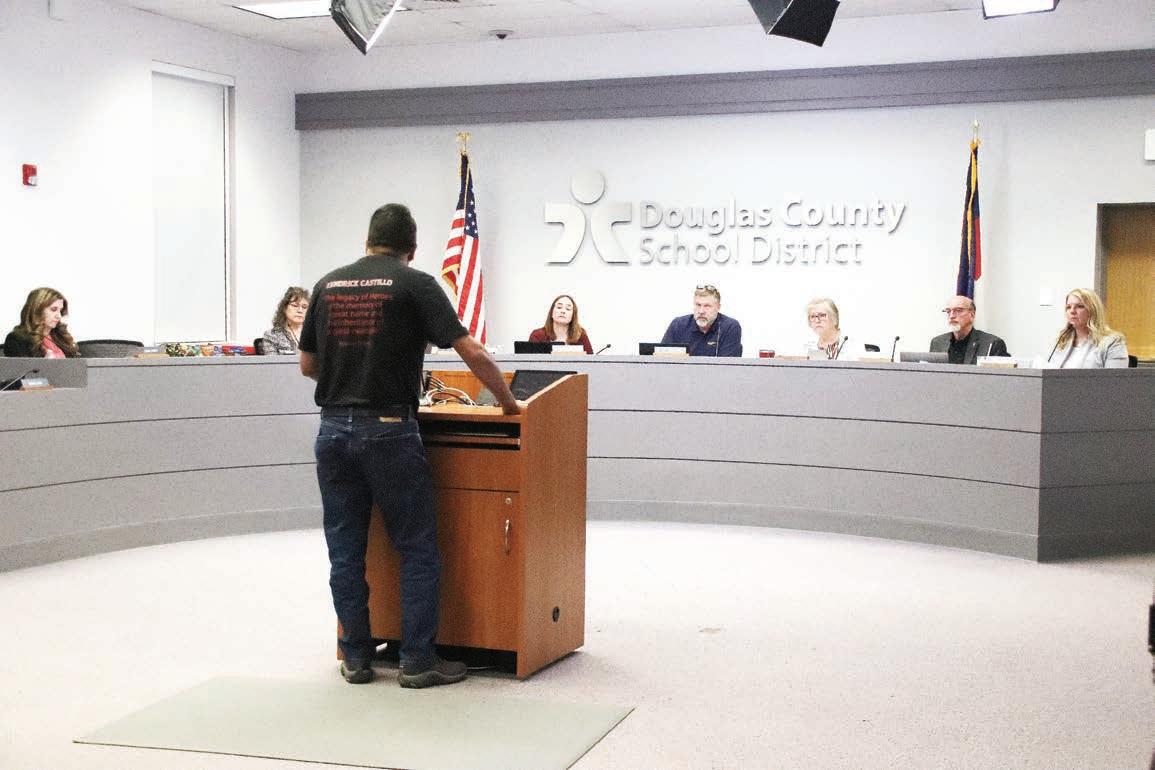

BY MCKENNA HARFORD MHARFORD@COLORADOCOMMUNITYMEDIA.COM
STEM School Highlands Ranch’s application to build a new school in Sterling Ranch was met with mixed responses from the public, including allegations from Kendrick Castillo’s father that STEM doesn’t keep its students safe enough.
STEM presented its plan to replicate the unique problem-based learning model it calls KOSON at a new K-12 school in Sterling Ranch to the Douglas County School Board on April 26. STEM was one of three charter schools to apply to open in the county next year, as well as Lehman Academy and Novastar Academy, which would be new to the district.
Most board directors didn’t express strong feelings either way for the proposed STEM School Sterling Ranch, but Director David Ray did question the logic of putting a charter school in Sterling Ranch when it doesn’t yet have a district school.
Ray also noted it would limit options for special education students.
“The reason I ask about your special education certainly is that without a neighborhood school in that community, we don’t have the potential of placing students into a signifi cant needs program,” he said.
KOSON CEO and former STEM executive director Penny Eucker said approving a charter doesn’t preclude other schools from the area and she would be happy to see options for parents and students.
Parents and community members were more vocal than the board, with many opposing STEM’s application and echoing Ray’s concerns about the lack of a district school in the neighborhood.
“Approving STEM and specifi cally approving STEM to occupy our only current site set aside for a school will set a standard that is fundamentally contrary to prioritizing neighborhood schools in the district’s newer and faster growing communities,” a Sterling Ranch resident said during public comment. “Many residents share reservations that if the board approves the application and a bond is passed in the near future, though no additional school sites have yet to be dedicated by the developer, the probability for a neighborhood school in the near future would be jeopardized.”
John Castillo, father of Kendrick Castillo, who died in the 2019 STEM shooting, told the Douglas County board he didn’t support another STEM school because of its inability to protect students like his son.
STEM Director of Communications Nicole Bostel told Colorado Community Media on April 29 that she couldn’t respond to Castillo’s specifi c comment because of ongoing litigation, but did speak to some of the safety measures STEM has installed at Highlands Ranch.
Bostel said several security systems are in place, including a background check program for visitors, an on-site school resource offi cer and a shot detection system that sends the school into lockdown, in addition to bullet-proofed windows and security doors.
A few parents did speak out in support for another STEM school and shared how the school’s problem-based learning model was crucial to making their students successful learners.
“Right now, all kids in Sterling Ranch have access to DCSD neighborhood schools, bus service and special needs programs,” said one mom during public comment. “Access to STEM is limited because there is no bus service and spots are limited. Adding a STEM school in Sterling Ranch will not take away existing DCSD schools or resources for special needs children either. Instead it would expand school choice for all.”
STEM’s presentation and application also gave more details about the proposed Sterling Ranch school, which would initially be an elementary school with the intent to ultimately teach K-12.
It’s fi rst year would serve just 100 students in grades K-3 with 10 instructional staff and fi ve administrative staff. The estimated operating budget is $1.4 million for the fi rst year.
Bostel said 98 families have signed the school’s intent to enroll form with just four of the families coming from outside the Sterling Ranch and Roxborough communities. Those 98 families represent interest in grades K-5, Bostel said.
Despite the negative comments, Bostel said STEM feels the presentation went well and they have a good chance of being approved.
Douglas County’s board will make the fi nal decision to approve or deny the application at its June 7 meeting. Until then, Bostel said STEM will ramp up community outreach, answer questions about the potential future school and grow the intent to enroll.
STEM is also in the process of applying to open an elementary school in the Denver Public School District on the same timeline of the Sterling Ranch school.


John Castillo speaks to the Douglas County School Board on April 26 in opposition of STEM School Highlands Ranch opening another campus in Sterling Ranch. Castillo’s son, Kendrick, died while protecting his classmates in a shooting at STEM School.
PHOTO BY JESSICA GIBBS
Local company, Veteran owned, Integrity focused
SOLAR SYSTEMS


Residential and Commercial Connects to CORE and Xcel
VOTED BEST ROOFING COMPANY TWO YEARS IN A ROW! THANK YOU.


